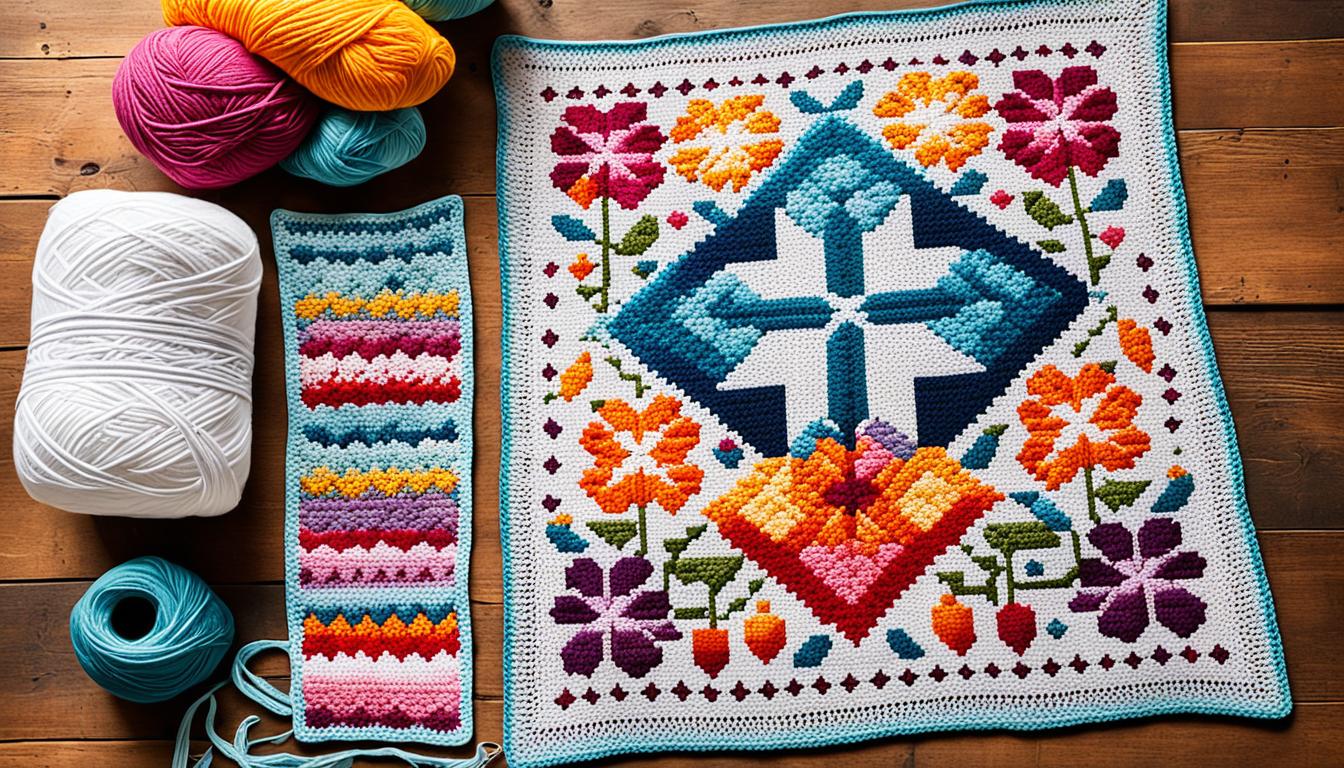Choosing between cross stitch and crochet can be both exciting and confusing. Each craft has its own unique qualities. The choice often depends on what you like, your skill level, and the projects you want to make. Whether you prefer the detailed nature of DIY cross stitch or the versatility of easy crochet projects, knowing the differences can help you decide.
For beginners, cross stitch might seem easier. It involves stitching X-shaped patterns on fabric with cross stitch kits. Crochet, on the other hand, lets you create different textures and shapes with loops and chains. It’s considered easier than knitting because you don’t have to worry about dropping stitches, making it great for newbies.
Both crafts are budget-friendly, with affordable materials like threads, hoops, and yarns. If you want to make handmade gifts that are special, both crafts are great options. You can create beautiful pieces, from intricate cross stitch patterns to colorful crochet patterns, and feel proud of your work.
Cross stitching is great for those who enjoy a calm, methodical activity. Crochet, however, is versatile and quick, offering instant satisfaction. Both crafts let you make stunning items, whether they’re standalone or part of a bigger project.
Key Takeaways
- Cross stitch and crochet offer unique experiences and benefits.
- DIY cross stitch involves stitching X-shaped patterns on fabric.
- Easy crochet projects are dynamic, offering various textures and shapes.
- Both crafts are cost-effective with low material costs.
- Handmade gifts made through these crafts are personal and unique.
Introduction to Cross Stitch and Crochet
Both cross stitch and crochet have a long history, now seen as artistic hobbies. They were once just needlework crafts but are now creative outlets for many. 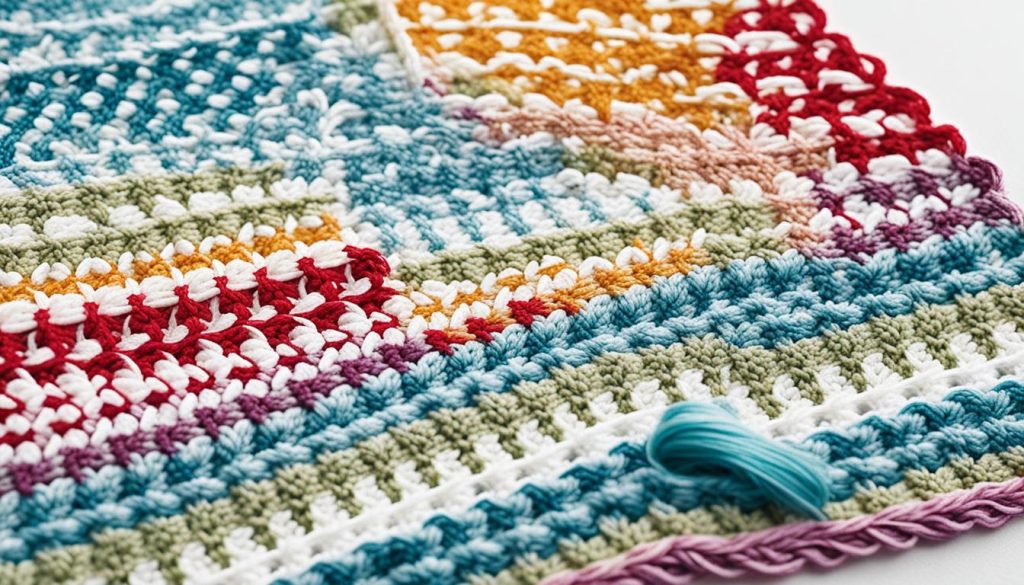
Cross stitch techniques use embroidery floss on Aida fabric, usually 14-count. Important steps include:
- Starting in the middle for better alignment
- Back stitches for borders, shown with colored lines
- French knots for details, considered intermediate to expert
- Burying thread ends to keep it from coming loose
- Ironing fabric first for a smooth surface
Crochet for beginners involves making loops and stitches with yarn and a hook. It’s popular in crochet forums. Key tips are:
- Switching colors by going through the last two loops
- Keeping fabric tight with an embroidery hoop
- Ironing the finished project to flatten it
- Adjusting the gauge for the right size, usually 2x to 4x
- Using sharp scissors for clean cuts
These crafts have seen a big comeback, creating active cross stitch communities and crochet forums. Sites like the Fat Quarter Shop offer free patterns. Kimberly Jolly guides beginners with lists of tools and materials.
The table below shows key differences between the two crafts:
| Aspect | Cross Stitch | Crochet |
|---|---|---|
| Basic Material | Aida Fabric, Embroidery Floss | Yarn, Hook |
| Starting Technique | From the center for alignment | Creating a foundation chain |
| Detailing | French knots, Back stitches | Color switching, Gauge adjustment |
| Pattern Indicators | Gridded charts with symbols | Written instructions and stitch diagrams |
Learning these basics of needlework crafts is a great start. The next sections will explore more about cross stitch and crochet. They’re perfect for those ready to dive into these creative hobbies.
What is Cross Stitch?
Cross stitch is a type of embroidery where X-shaped stitches create pictures. It uses fabrics like linen, aida cloth, and jobelan. These fabrics have threads per inch from 11 to 40 count. Cotton floss is the top choice for threads, with DMC and Anchor being well-known brands.
Basic Techniques and Styles
There are two main styles in cross stitch: counted and stamped cross stitch. Counted cross stitch uses graph paper with each square representing a stitch. It requires precision and counting fabric threads carefully. Stamped cross stitch, on the other hand, uses fabric with pre-printed patterns. This makes it easier and quicker for beginners.
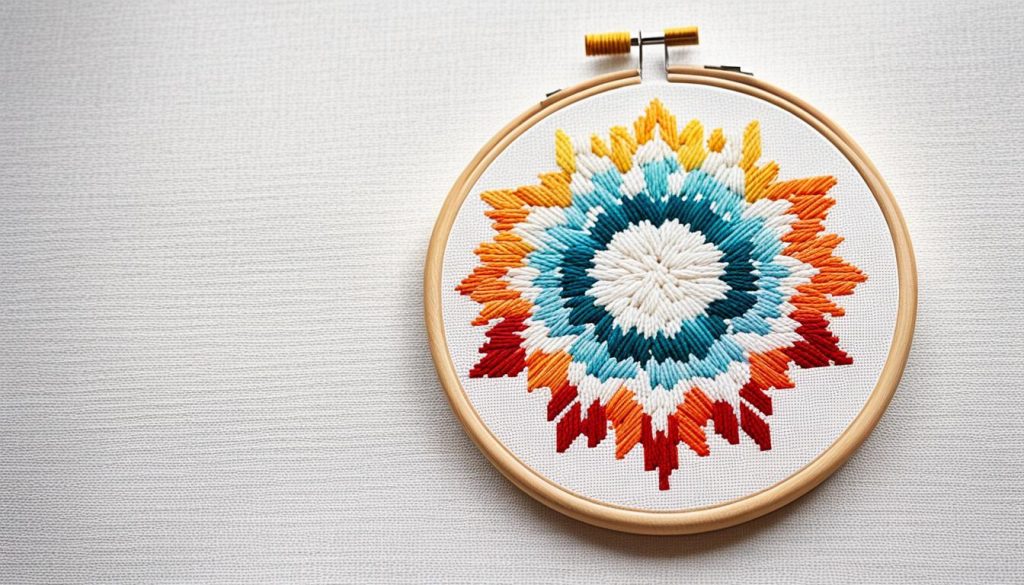
Modern cross stitch is a new trend that brings a fresh twist to the craft. It uses modern themes and designs, often with a humorous touch. This style features bold colors and unique patterns, appealing to younger stitchers and those looking for something different.
Beginner Cross Stitch Tips
For beginners, start with simple cross stitch patterns to gain confidence. Aida cloth is a good fabric choice because of its even weave and clear holes. Use cotton floss from DMC or Anchor for quality and a wide range of colors.
- Pick a pattern with few colors and big stitching areas.
- Use a thread organizer to keep your threads tidy.
- Make sure you have good lighting to avoid eye strain.
- Begin stitching from the fabric’s center for symmetry.
Also, practice basic stitches like the backstitch and half-stitch to improve your skills.
Popular Cross Stitch Patterns and Designs
There are many free cross stitch patterns online for different tastes and skills. You can find cross stitch alphabets and intricate floral designs. Modern patterns feature retro images or contemporary sayings, showing how the craft is evolving.
Cross stitch magazines and online sites offer lots of patterns. Whether you like traditional or modern styles, you’ll find something you like. This craft is loved for its flexibility and letting you make unique art pieces.
What is Crochet?
Crochet is a fun and flexible yarn craft. It involves making fabric by hooking yarn loops together. Unlike knitting, which uses two needles, crochet only needs one hook. This craft offers a wide range of projects, from simple stitches to complex amigurumi designs.
Fundamental Crochet Techniques
Learning basic crochet techniques is key for any beginner. You’ll learn stitches like the single crochet, half double crochet, and double crochet. These stitches are the base for more complex patterns. Also, the single crochet cross stitch is a useful technique for creating a solid texture.
Crochet for Beginners
For those new to crochet, there are many easy projects to start with. You’ll learn how to hold the hook and yarn, and get to know the basic stitches. Projects like crochet blankets, simple scarves, and hats are great for beginners.
Working row by row for a vertical section in cross stitch on crochet can create a more organized design.
Popular Crochet Patterns
Crochet patterns offer endless creativity. You can make everything from cozy blankets to cute amigurumi figures. Amigurumi, a Japanese craft of making small yarn animals, is very popular. Mixing crochet stitches with creative designs leads to unique and adorable projects.
Personalized items like pillows, hats, and bags are great projects. They combine cross stitch with crochet. With practice, you can even try more complex techniques and patterns.
Comparing the Costs: Cross Stitch vs. Crochet
When deciding between cross stitch and crochet on a budget, knowing the cost differences is key. Both require an initial investment in supplies, but the items and their prices vary a lot.
Cost of Supplies
For cross stitch, you’ll need fabric, needles, and threads. Kits for beginners cost between $5 to $10, depending on size and materials. If you don’t use kits, the costs can add up:
- Plain fabric: A 15″x18″ piece of 14 count Aida costs around $3.99.
- Advanced fabric: 28 count evenweave costs $5.24 for 13″x18″, while linen of the same size is $8.24.
- Hand-dyed fabric: For premium projects, a 17″x25″ piece of 32 count linen can cost between $25 and $30.
- Threads: DMC floss costs approximately $0.62 per skein, with fancy hand-dyed options priced at $2-$3 per skein.
- Needles: A pack of 6 tapestry needles generally costs around $2.99.
- Patterns: Digital versions range from $3 to $10, and printed patterns range from $8 to $20.
In crochet, the main supplies are yarn and hooks. Here’s what you might pay:
- Yarn: Quality yarn costs between $3 and $10 per skein, with higher quality yarns being more expensive.
- Hooks: A set of crochet hooks can range from $5 to $15 based on the material and brand.
Long-term Investment
Choosing quality materials can greatly improve your crafting projects. High-end cross stitch fabrics and threads are more durable and look better. Similarly, premium crochet hooks and yarn can make your projects better.
Let’s look at software costs for designing your own cross stitch patterns:
| Software | Price | Rating | Reviews |
|---|---|---|---|
| WinStitch | $52 (discounted to $40) | 10/10 | 6,898 |
| PC Stitch | $50 (discounted to $20) | 8.5/10 | 7,231 |
| KG Chart | $35 | 7/10 | 3,531 |
Whether you pick cross stitch or crochet, planning your budget is key. Both crafts have different costs, but with careful planning, you can enjoy them without spending too much.
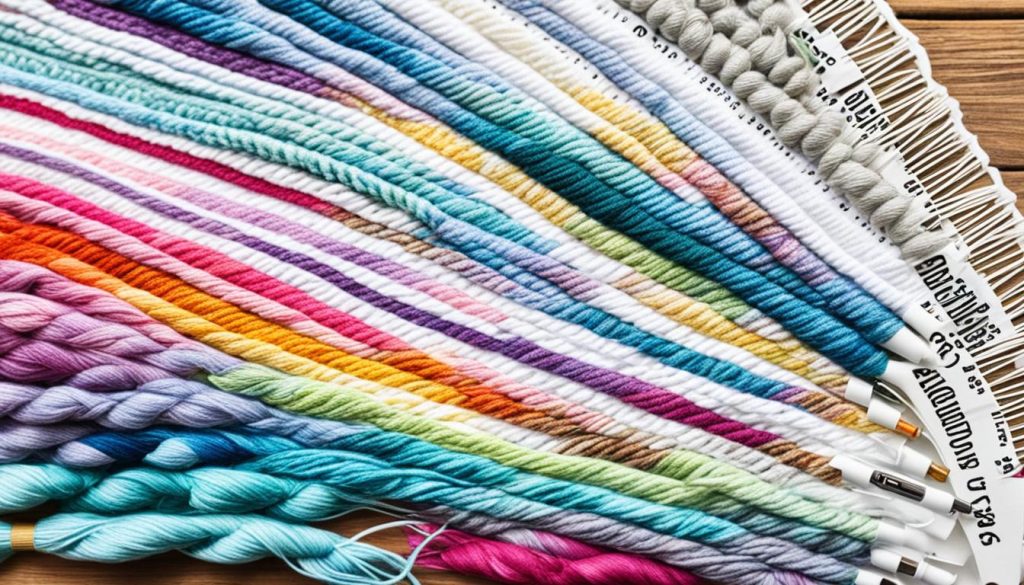
Benefits of Cross Stitch
Embracing cross stitch brings many advantages, from helping with stress to making great gifts. It’s a mix of relaxation and creativity, perfect for many hobbies.
Therapeutic Benefits
Cross stitching is known for its calming effects, acting like a mindfulness craft. It lowers stress hormones and helps you focus. This hobby can make you feel happy by releasing feel-good chemicals in your brain.
It also boosts brain skills and helps with patience and perseverance. These are important for many life areas.
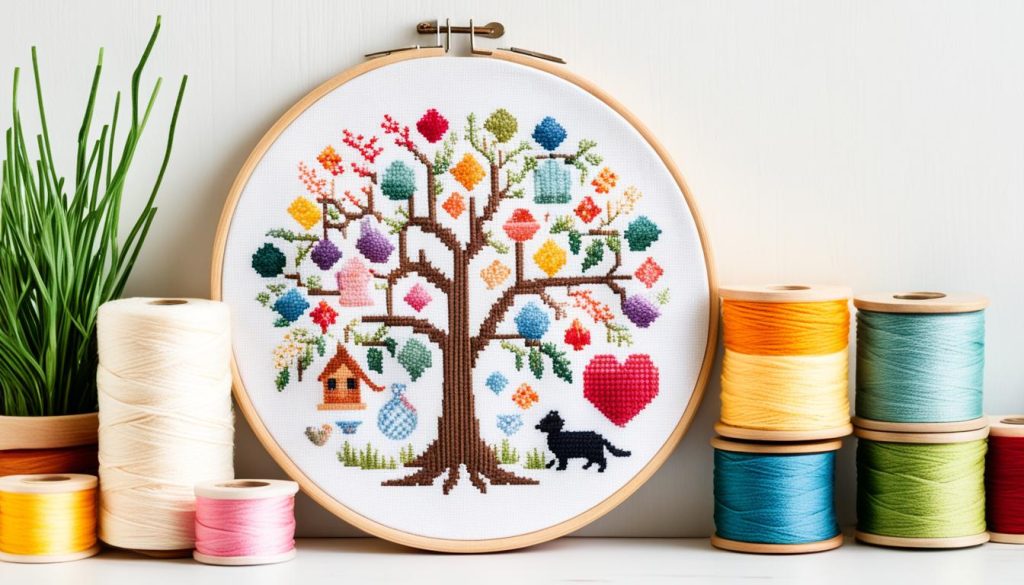
Plus, it improves self-awareness and decision-making. The task requires focus, which helps the brain heal. People feel proud and accomplished when they finish a project.
Versatility in Gift Making
Cross stitch is great for making unique gifts and decor. It lets you add a personal touch to items. You can make anything from pillows to art, making each piece special.
It also makes your home look better. Handmade items bring warmth and show off your style. They tell stories and keep traditions alive.
It’s also easy on the wallet, with low costs for starting out. You can take it anywhere, making it a fun way to be creative anytime.
In short, cross stitch is rewarding in many ways. It’s good for your mind and lets you be creative. Whether you want to relax or make gifts, it’s a hobby that lasts.
| Benefits | Details |
|---|---|
| Mental Well-being | Reduces anxiety and cortisol levels, promotes happiness through serotonin and dopamine release |
| Motor Skills | Enhances fine motor skills and hand-eye coordination |
| Concentration and Patience | Improves focus and decision-making skills, fosters patience |
| Social Interaction | Offers opportunities for social bonding within communities |
| Affordability | Budget-friendly, requiring minimal investment |
Benefits of Crochet
Crochet is more than just a hobby; it’s a way to improve mental health. DIY crochet projects bring calmness and help with relaxation. The simple, repetitive motion of crocheting can lower stress and tension.
The crochet community is a supportive space for crafters at every level. It’s a place to share your handcrafted crochet items and learn new skills. With about 481,000 users on Reddit, the online crochet community is big and active, full of patterns and support.
Crochet therapy helps fight depression by keeping the mind focused and active. It stimulates brain activity, leading to better mental health. It also helps create new neural pathways, learn new skills, and boost self-esteem.
Crocheting can distract you from bad habits like nail-biting, smoking, or eating too much. Keeping your hands busy with DIY crochet projects helps you focus on something positive. This supports your overall well-being.
Crochet promotes mindfulness with its rhythmic patterns. It’s perfect for those wanting to be more present. The touch of different textures and materials is great for people with Alzheimer’s or dementia.
Regular crochet practice improves hand-eye coordination and dexterity. This can lower the risk of arthritis in the hands. Crochet lets you express your creativity with patterns, colors, and textures. You can make clothes, blankets, or accessories, making it both practical and fulfilling.
Cross Stitch for Beginners: Getting Started
If you’re ready to try cross stitching, you’re in for a fun and calming hobby. It’s easy to start with the right materials and some basic knowledge. We’ll guide you through the essentials of a cross stitch kit and the basics of the craft.
First, let’s talk about what you need for a basic cross stitch kit. Here’s a quick list of supplies you should get:
- Pattern: Choose a pattern you like; it will have a grid with colored squares and symbols, each for one cross stitch.
- Fabric: Use 14 count Aida cloth, it has evenly spaced holes for easy counting and stitching.
- Embroidery floss: Work with two strands of embroidery floss, and each strand is six threads twisted together.
- Needle: Use a round-end tapestry needle, and pick the right size for your fabric.
- Embroidery hoop: This tool keeps your fabric tight and easy to stitch on.
With your cross stitch kit ready, it’s time to start stitching. Follow these basics for a great experience:
- Prepare your floss: Cut 18 inches of floss and split it into two strands. Use one or two strands for even tension and to avoid lumps.
- Thread your needle: Secure the thread without knots. Run the needle under three stitches on the back to finish a thread.
- Start stitching: Begin in rows from left to right. Make sure to stitch rows of the same color before moving on to avoid long jumps.
- Maintain even tension: Keep your fabric tight in the hoop to prevent warping. Let the needle and thread unwind to avoid twisting.
- Complete and secure: Finish by threading the needle under three stitches on the back to secure the thread.
Here are more tips to improve your cross-stitching:
| Tips | Details |
|---|---|
| Purchase Supplies Early | Buy all your supplies at the start to avoid dye lot issues. |
| Relaxing Craft | Enjoy cross stitch as a calming activity for all ages. |
| Shipping Perk | Orders over $75 get free U.S. shipping. |
| Avoid Long Jumps | Don’t make long jumps across the fabric’s back to prevent thread showing. |
Starting cross stitch is easy with these steps. There are many online tutorials that offer clear instructions. Enjoy the process, and happy stitching!
Crochet for Beginners: Getting Started
Starting your crochet journey can be thrilling and a bit daunting. But, with the right crochet tools and accessories and some easy patterns, you’ll be making things quickly. You can choose to take crochet classes or learn on your own, there are many ways to begin.
Recommended Tools
First, gather the key crochet tools and accessories you’ll need. Here’s what beginners should start with:
- Crochet Hooks: Start with a H/5mm hook, as it’s a good size for beginners.
- Yarn: Choose worsted weight yarn for its versatility and easy handling.
- Yarn Snips: These are crucial for cutting yarn cleanly.
- Tapestry Needle: This needle is great for weaving in yarn ends.
First Projects to Try
Begin with simple beginner crochet patterns to practice and gain confidence. Consider these projects for your first tries:
- Headbands: Make a trendy headband with the single crochet stitch, great for cold days.
- Wrist Warmers: These are perfect for practicing stitches in a round shape.
- Basic Bags: A simple tote or drawstring bag is a great first project.
If you like structured learning, try crochet classes. Look for online or local classes. Many suggest Craftsy or workshops at yarn stores for hands-on help.
Or, if you prefer learning by yourself, you can be a self-taught crochet expert. There are plenty of online tutorials, patterns, and forums to help you along the way.
Conclusion
Starting your craft journey can be exciting, whether you pick cross stitch or crochet. Cross stitch brings a sense of calm and focus. It helps improve fine motor skills and reduces stress by making you mindful.
Crochet has its own benefits too. It lets you make everything from cozy clothes to beautiful home decor. Beginners can start with simple techniques and move to complex patterns as they get better.
Choosing between cross stitch and crochet depends on what you like and how much time you have. Both crafts let you be creative in different ways. Always read the instructions well to avoid mistakes and enjoy your project more.
Whether you go for cross stitch or crochet, both will make your life richer. They offer many possibilities for new projects and hobbies. Embrace your craft journey and find what works best for you.
